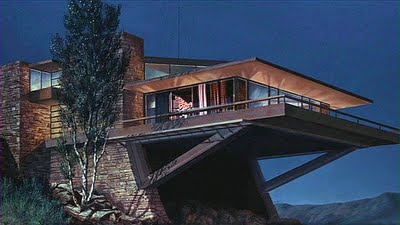When Design Was Thrilling

The other night, I introduced to my son North by Northwest, a 1959 Hitchcock’s classic with a “design theme”, and soon we were both entranced.
In mid-century cinema, modern design either served as a symbol of human alienation (Antonioni), or was ridiculed for its awkwardness and sterility (Jacques Tati). In contrast, Hitchcock acknowledged modern design for its spectacular, thrilling potential, not without a certain sinister edge. A series of dramatic shots of the UN Building in New York City (newly constructed at the time of filming) end up in a murder. A hyper-modern house of the film’s evil protagonist also becomes a scene of deadly confrontation. In this context, it makes sense that the leading lady, a secret service agent, gives her occupation as “an industrial designer”.
Far from offering any commentary on these modernist backgrounds, Hitchcock was simply affected by their fresh visual impact. In this, he prefigured the age of glossy fashion magazines, where contemporary architecture is often used to the same superficial effect – which by now lost any possibility to thrill.


4 Comments:
"In this, [Hitchcock] prefigured the age of glossy fashion magazines, where contemporary architecture is often used to the same superficial effect – which by now lost any possibility to thrill.
I'm not entirely sure this is a correct reading, rather I suggest boredom, from over-exposure of the new and the hyper-competitive environment where designers and architects compete with each other in games that are of little use to the consumers of their products, goods or environments.
The High Line is a good example of this—on paper, it promises a thrilling passage through space and time. In reality, it is as artificial as a boardwalk leading into a Vegas casino. It could have been extruded in Stuttgart or lowered by a crane in Shanghai. By contrast, Mid-Century modern architecture thrilled film makers because it revealed all the potentials and contradictions, pain and pleasure, of the promises offered by industrialization, etc. Instead, everything that held that promised was reduced to one stereotype or another until people stopped looking, and sadly, stopped caring. Objects in the end, ceased to be things but simply stood for things.
Eva Marie-Saint: "I'm an industrial designer." Doesn't get a lot more thrilling than THAT.
All very good comments. Hitch liked to take the audiences to rich places they couldn't afford (the Ambassador East in Chicago). But, I also think that the modern architecture angle might have something to do with the fact "commie" villain lived there. You know how those modern artists are. (Just kidding)
i am definitely watching this. miss you guys!
Post a Comment
Subscribe to Post Comments [Atom]
<< Home